SEO for Desklib - Online Library for Study Material
VerifiedAdded on 2023/06/11
|11
|2457
|256
AI Summary
This portfolio showcases artifacts related to IT project management, including ERP implementation, data encryption, IT communications and training, database and project design, automated data analysis, and risk analysis and management.
Contribute Materials
Your contribution can guide someone’s learning journey. Share your
documents today.

qwertyuiopasdfghjklzxcvbnmqw
ertyuiopasdfghjklzxcvbnmqwert
yuiopasdfghjklzxcvbnmqwertyui
opasdfghjklzxcvbnmqwertyuiop
asdfghjklzxcvbnmqwertyuiopasd
fghjklzxcvbnmqwertyuiopasdfgh
jklzxcvbnmqwertyuiopasdfghjkl
zxcvbnmqwertyuiopasdfghjklzxc
vbnmqwertyuiopasdfghjklzxcvb
nmqwertyuiopasdfghjklzxcvbnm
qwertyuiopasdfghjklzxcvbnmqw
ertyuiopasdfghjklzxcvbnmqwert
yuiopasdfghjklzxcvbnmqwertyui
opasdfghjklzxcvbnmqwertyuiop
asdfghjklzxcvbnmqwertyuiopasd
fghjklzxcvbnmqwertyuiopasdfgh
jklzxcvbnmrtyuiopasdfghjklzxcv
IT Portfolio
6/21/2018
ertyuiopasdfghjklzxcvbnmqwert
yuiopasdfghjklzxcvbnmqwertyui
opasdfghjklzxcvbnmqwertyuiop
asdfghjklzxcvbnmqwertyuiopasd
fghjklzxcvbnmqwertyuiopasdfgh
jklzxcvbnmqwertyuiopasdfghjkl
zxcvbnmqwertyuiopasdfghjklzxc
vbnmqwertyuiopasdfghjklzxcvb
nmqwertyuiopasdfghjklzxcvbnm
qwertyuiopasdfghjklzxcvbnmqw
ertyuiopasdfghjklzxcvbnmqwert
yuiopasdfghjklzxcvbnmqwertyui
opasdfghjklzxcvbnmqwertyuiop
asdfghjklzxcvbnmqwertyuiopasd
fghjklzxcvbnmqwertyuiopasdfgh
jklzxcvbnmrtyuiopasdfghjklzxcv
IT Portfolio
6/21/2018
Secure Best Marks with AI Grader
Need help grading? Try our AI Grader for instant feedback on your assignments.
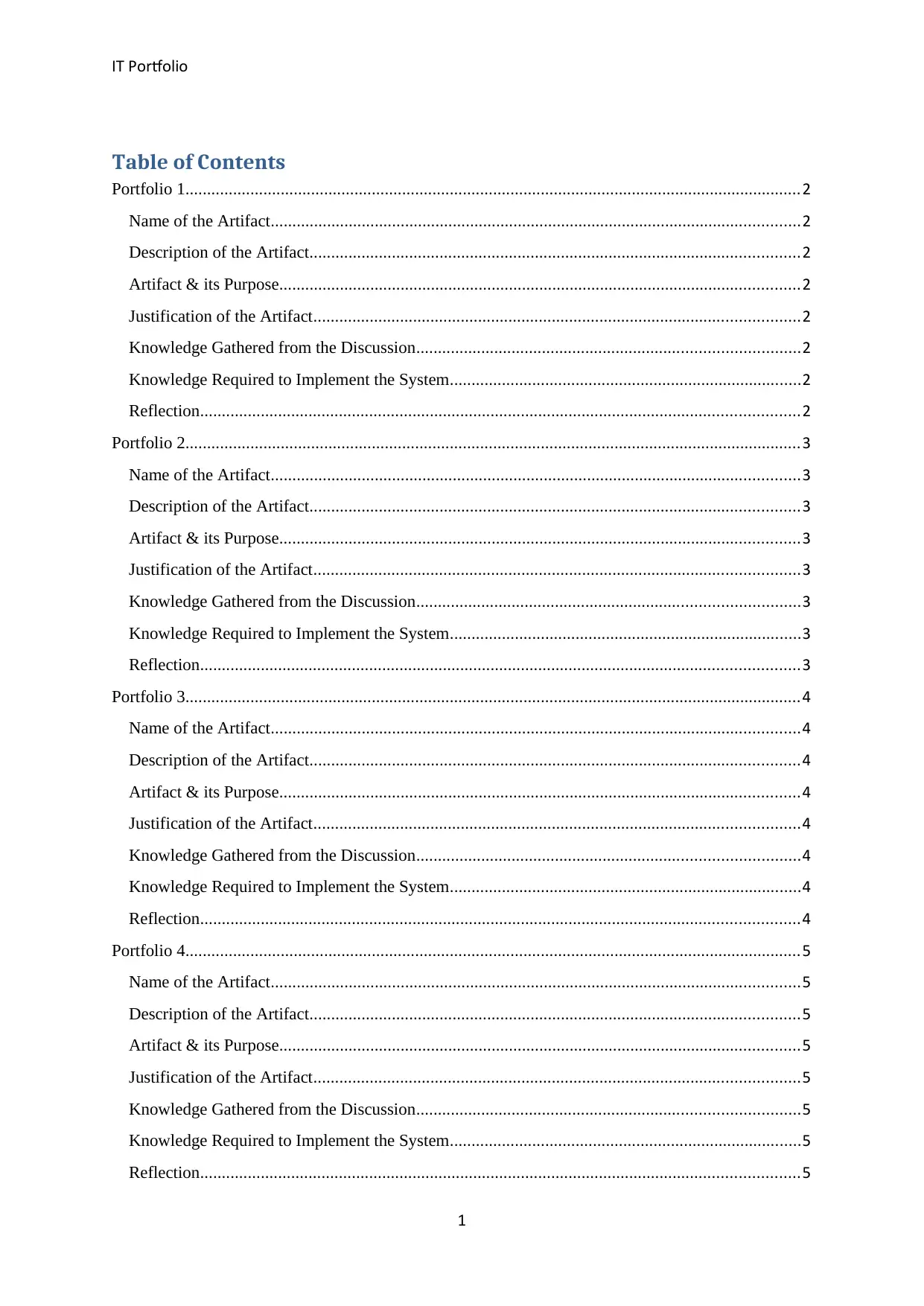
IT Portfolio
Table of Contents
Portfolio 1..............................................................................................................................................2
Name of the Artifact..........................................................................................................................2
Description of the Artifact.................................................................................................................2
Artifact & its Purpose........................................................................................................................2
Justification of the Artifact................................................................................................................2
Knowledge Gathered from the Discussion........................................................................................2
Knowledge Required to Implement the System.................................................................................2
Reflection..........................................................................................................................................2
Portfolio 2..............................................................................................................................................3
Name of the Artifact..........................................................................................................................3
Description of the Artifact.................................................................................................................3
Artifact & its Purpose........................................................................................................................3
Justification of the Artifact................................................................................................................3
Knowledge Gathered from the Discussion........................................................................................3
Knowledge Required to Implement the System.................................................................................3
Reflection..........................................................................................................................................3
Portfolio 3..............................................................................................................................................4
Name of the Artifact..........................................................................................................................4
Description of the Artifact.................................................................................................................4
Artifact & its Purpose........................................................................................................................4
Justification of the Artifact................................................................................................................4
Knowledge Gathered from the Discussion........................................................................................4
Knowledge Required to Implement the System.................................................................................4
Reflection..........................................................................................................................................4
Portfolio 4..............................................................................................................................................5
Name of the Artifact..........................................................................................................................5
Description of the Artifact.................................................................................................................5
Artifact & its Purpose........................................................................................................................5
Justification of the Artifact................................................................................................................5
Knowledge Gathered from the Discussion........................................................................................5
Knowledge Required to Implement the System.................................................................................5
Reflection..........................................................................................................................................5
1
Table of Contents
Portfolio 1..............................................................................................................................................2
Name of the Artifact..........................................................................................................................2
Description of the Artifact.................................................................................................................2
Artifact & its Purpose........................................................................................................................2
Justification of the Artifact................................................................................................................2
Knowledge Gathered from the Discussion........................................................................................2
Knowledge Required to Implement the System.................................................................................2
Reflection..........................................................................................................................................2
Portfolio 2..............................................................................................................................................3
Name of the Artifact..........................................................................................................................3
Description of the Artifact.................................................................................................................3
Artifact & its Purpose........................................................................................................................3
Justification of the Artifact................................................................................................................3
Knowledge Gathered from the Discussion........................................................................................3
Knowledge Required to Implement the System.................................................................................3
Reflection..........................................................................................................................................3
Portfolio 3..............................................................................................................................................4
Name of the Artifact..........................................................................................................................4
Description of the Artifact.................................................................................................................4
Artifact & its Purpose........................................................................................................................4
Justification of the Artifact................................................................................................................4
Knowledge Gathered from the Discussion........................................................................................4
Knowledge Required to Implement the System.................................................................................4
Reflection..........................................................................................................................................4
Portfolio 4..............................................................................................................................................5
Name of the Artifact..........................................................................................................................5
Description of the Artifact.................................................................................................................5
Artifact & its Purpose........................................................................................................................5
Justification of the Artifact................................................................................................................5
Knowledge Gathered from the Discussion........................................................................................5
Knowledge Required to Implement the System.................................................................................5
Reflection..........................................................................................................................................5
1
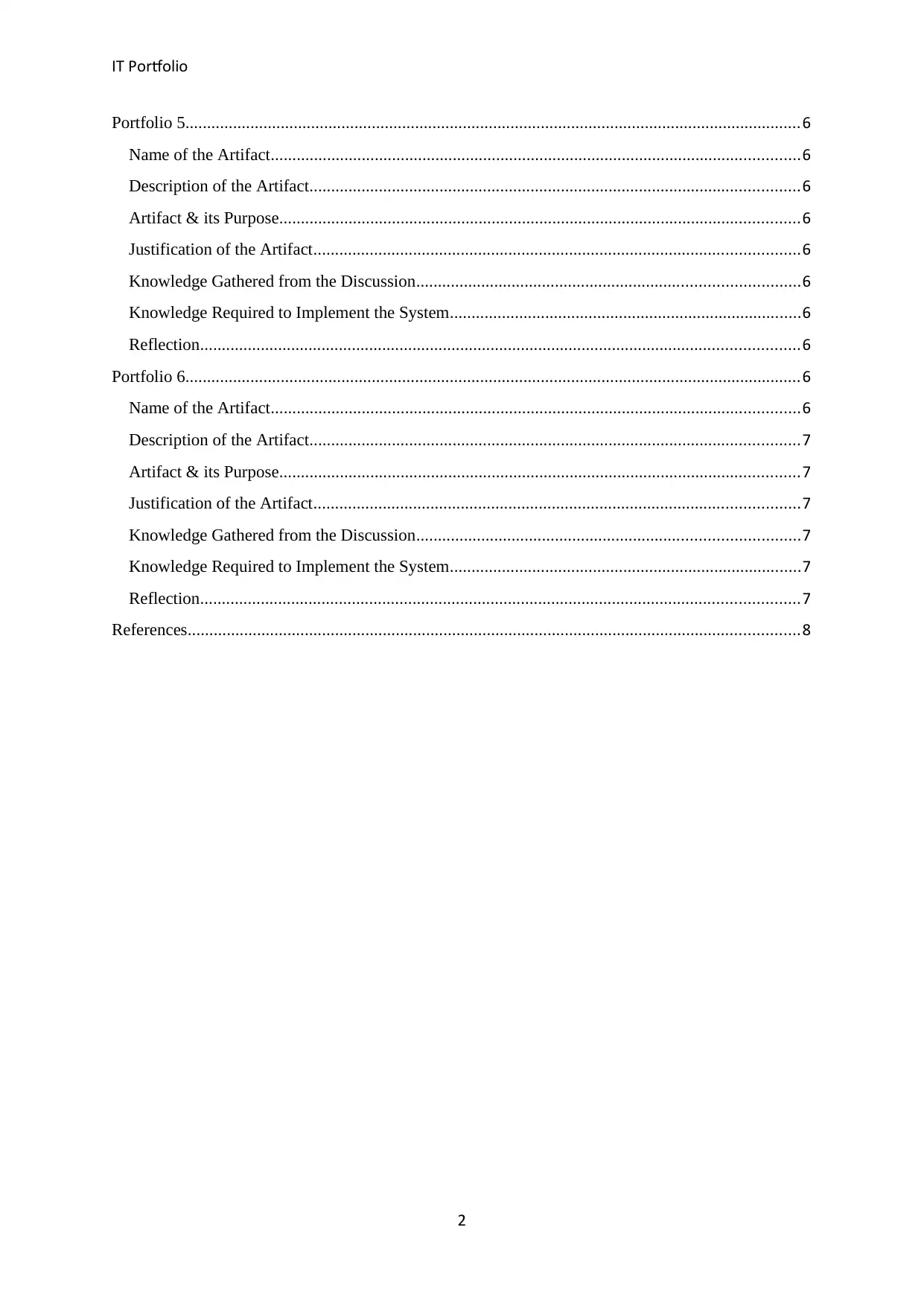
IT Portfolio
Portfolio 5..............................................................................................................................................6
Name of the Artifact..........................................................................................................................6
Description of the Artifact.................................................................................................................6
Artifact & its Purpose........................................................................................................................6
Justification of the Artifact................................................................................................................6
Knowledge Gathered from the Discussion........................................................................................6
Knowledge Required to Implement the System.................................................................................6
Reflection..........................................................................................................................................6
Portfolio 6..............................................................................................................................................6
Name of the Artifact..........................................................................................................................6
Description of the Artifact.................................................................................................................7
Artifact & its Purpose........................................................................................................................7
Justification of the Artifact................................................................................................................7
Knowledge Gathered from the Discussion........................................................................................7
Knowledge Required to Implement the System.................................................................................7
Reflection..........................................................................................................................................7
References.............................................................................................................................................8
2
Portfolio 5..............................................................................................................................................6
Name of the Artifact..........................................................................................................................6
Description of the Artifact.................................................................................................................6
Artifact & its Purpose........................................................................................................................6
Justification of the Artifact................................................................................................................6
Knowledge Gathered from the Discussion........................................................................................6
Knowledge Required to Implement the System.................................................................................6
Reflection..........................................................................................................................................6
Portfolio 6..............................................................................................................................................6
Name of the Artifact..........................................................................................................................6
Description of the Artifact.................................................................................................................7
Artifact & its Purpose........................................................................................................................7
Justification of the Artifact................................................................................................................7
Knowledge Gathered from the Discussion........................................................................................7
Knowledge Required to Implement the System.................................................................................7
Reflection..........................................................................................................................................7
References.............................................................................................................................................8
2

IT Portfolio
Portfolio 1
Name of the Artifact
Advanced Information System Implementation – ERP System
Description of the Artifact
Enterprise Resource Planning (ERP) systems are the advanced process management and
information system that integrate and automate the back-end operations carried out in an
organization.
Artifact & its Purpose
Mesfine Industrial Engineering (MIE) Pvt Ltd is a medium scale Ethiopian organization that
works in the area of metal construction and engineering and implemented ERP systems for
enhanced technical automation and integration at the workplace ((Boltena & Gomez, 2012).
Justification of the Artifact
The artifact has been selected as it streamlines the technical processes and operations,
introduces enhanced flexibility and mobility and also promotes the security of the
information and data sets.
Knowledge Gathered from the Discussion
The implementation of an advanced system, such as ERP requires a phased approach of
implementation with critical phases as planning, execution, control, and closure. It is
necessary to plan the schedule and budget of the implementation process in advance.
Knowledge Required to Implement the System
The results of the feasibility and compatibility analysis, details of the technical infrastructure
and estimations are required to implement the system.
Reflection
I learned the requirement and approach that shall be followed for the implementation of the
advanced information system as ERP. I could also gain the understanding on the relevance of
such systems in the medium and large scale organizations. The implementation process came
up with the technical challenges and risks associated with information security and privacy. If
given a chance, I would use advanced access control tools in the system before implementing
the same.
3
Portfolio 1
Name of the Artifact
Advanced Information System Implementation – ERP System
Description of the Artifact
Enterprise Resource Planning (ERP) systems are the advanced process management and
information system that integrate and automate the back-end operations carried out in an
organization.
Artifact & its Purpose
Mesfine Industrial Engineering (MIE) Pvt Ltd is a medium scale Ethiopian organization that
works in the area of metal construction and engineering and implemented ERP systems for
enhanced technical automation and integration at the workplace ((Boltena & Gomez, 2012).
Justification of the Artifact
The artifact has been selected as it streamlines the technical processes and operations,
introduces enhanced flexibility and mobility and also promotes the security of the
information and data sets.
Knowledge Gathered from the Discussion
The implementation of an advanced system, such as ERP requires a phased approach of
implementation with critical phases as planning, execution, control, and closure. It is
necessary to plan the schedule and budget of the implementation process in advance.
Knowledge Required to Implement the System
The results of the feasibility and compatibility analysis, details of the technical infrastructure
and estimations are required to implement the system.
Reflection
I learned the requirement and approach that shall be followed for the implementation of the
advanced information system as ERP. I could also gain the understanding on the relevance of
such systems in the medium and large scale organizations. The implementation process came
up with the technical challenges and risks associated with information security and privacy. If
given a chance, I would use advanced access control tools in the system before implementing
the same.
3
Secure Best Marks with AI Grader
Need help grading? Try our AI Grader for instant feedback on your assignments.
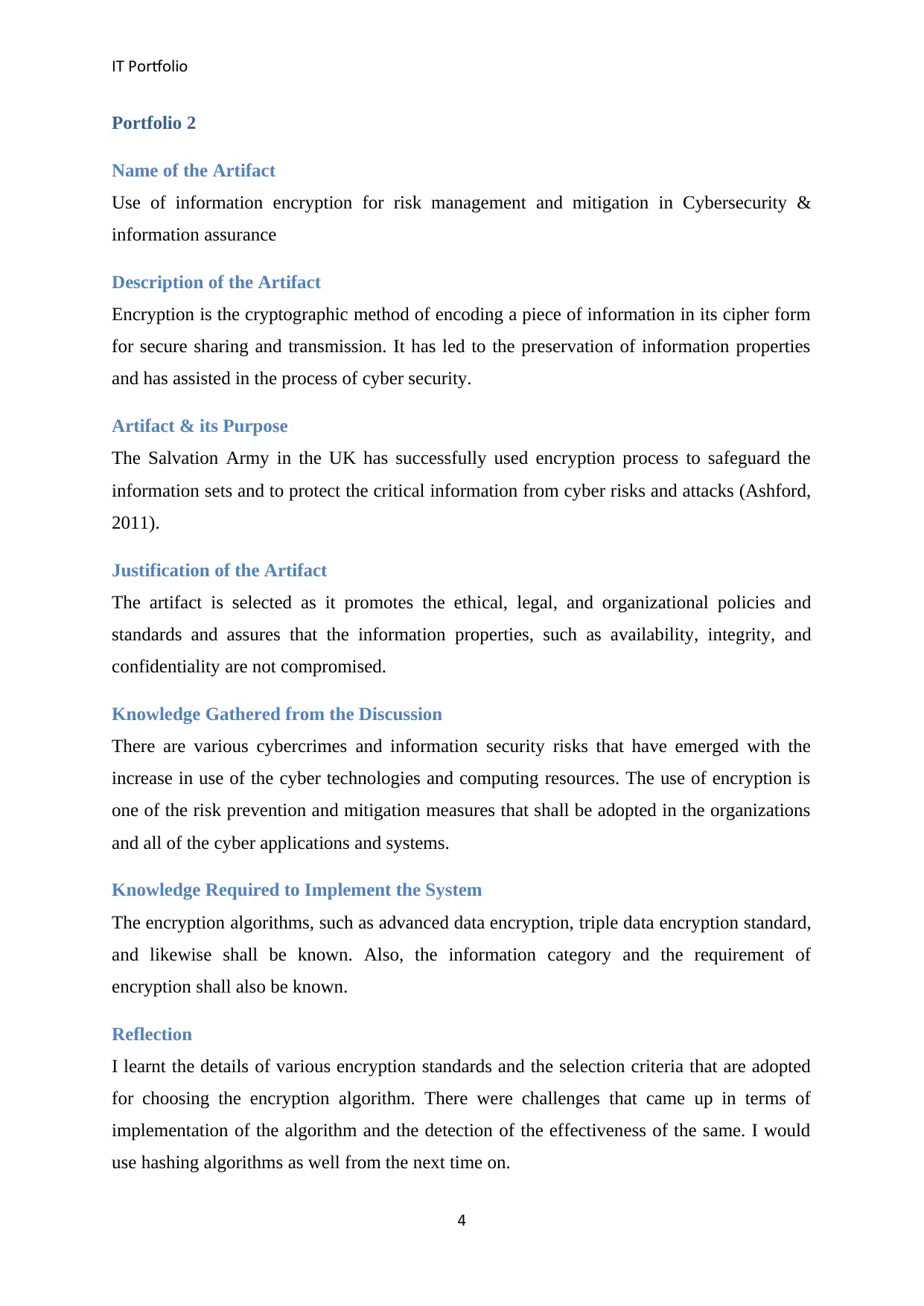
IT Portfolio
Portfolio 2
Name of the Artifact
Use of information encryption for risk management and mitigation in Cybersecurity &
information assurance
Description of the Artifact
Encryption is the cryptographic method of encoding a piece of information in its cipher form
for secure sharing and transmission. It has led to the preservation of information properties
and has assisted in the process of cyber security.
Artifact & its Purpose
The Salvation Army in the UK has successfully used encryption process to safeguard the
information sets and to protect the critical information from cyber risks and attacks (Ashford,
2011).
Justification of the Artifact
The artifact is selected as it promotes the ethical, legal, and organizational policies and
standards and assures that the information properties, such as availability, integrity, and
confidentiality are not compromised.
Knowledge Gathered from the Discussion
There are various cybercrimes and information security risks that have emerged with the
increase in use of the cyber technologies and computing resources. The use of encryption is
one of the risk prevention and mitigation measures that shall be adopted in the organizations
and all of the cyber applications and systems.
Knowledge Required to Implement the System
The encryption algorithms, such as advanced data encryption, triple data encryption standard,
and likewise shall be known. Also, the information category and the requirement of
encryption shall also be known.
Reflection
I learnt the details of various encryption standards and the selection criteria that are adopted
for choosing the encryption algorithm. There were challenges that came up in terms of
implementation of the algorithm and the detection of the effectiveness of the same. I would
use hashing algorithms as well from the next time on.
4
Portfolio 2
Name of the Artifact
Use of information encryption for risk management and mitigation in Cybersecurity &
information assurance
Description of the Artifact
Encryption is the cryptographic method of encoding a piece of information in its cipher form
for secure sharing and transmission. It has led to the preservation of information properties
and has assisted in the process of cyber security.
Artifact & its Purpose
The Salvation Army in the UK has successfully used encryption process to safeguard the
information sets and to protect the critical information from cyber risks and attacks (Ashford,
2011).
Justification of the Artifact
The artifact is selected as it promotes the ethical, legal, and organizational policies and
standards and assures that the information properties, such as availability, integrity, and
confidentiality are not compromised.
Knowledge Gathered from the Discussion
There are various cybercrimes and information security risks that have emerged with the
increase in use of the cyber technologies and computing resources. The use of encryption is
one of the risk prevention and mitigation measures that shall be adopted in the organizations
and all of the cyber applications and systems.
Knowledge Required to Implement the System
The encryption algorithms, such as advanced data encryption, triple data encryption standard,
and likewise shall be known. Also, the information category and the requirement of
encryption shall also be known.
Reflection
I learnt the details of various encryption standards and the selection criteria that are adopted
for choosing the encryption algorithm. There were challenges that came up in terms of
implementation of the algorithm and the detection of the effectiveness of the same. I would
use hashing algorithms as well from the next time on.
4
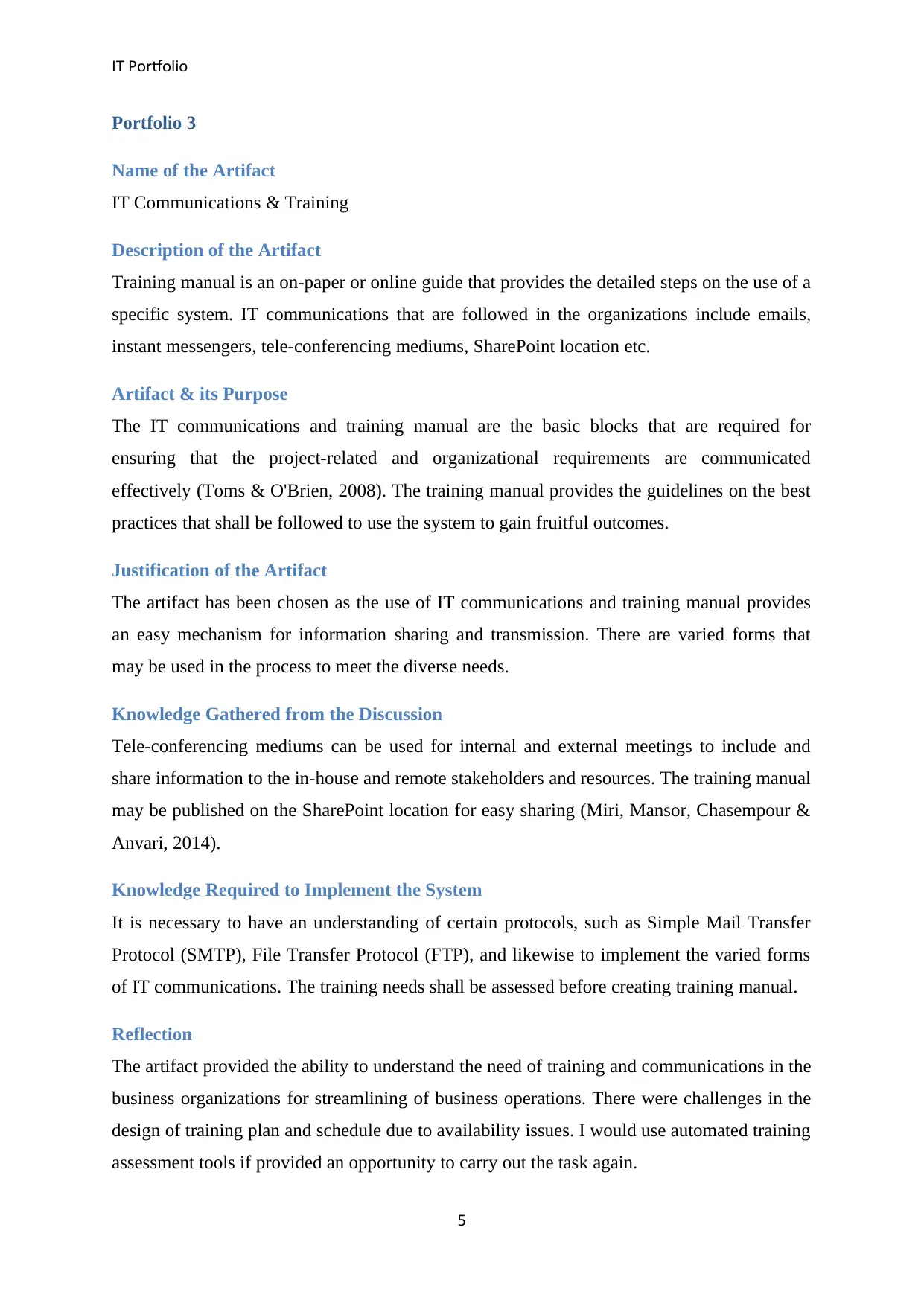
IT Portfolio
Portfolio 3
Name of the Artifact
IT Communications & Training
Description of the Artifact
Training manual is an on-paper or online guide that provides the detailed steps on the use of a
specific system. IT communications that are followed in the organizations include emails,
instant messengers, tele-conferencing mediums, SharePoint location etc.
Artifact & its Purpose
The IT communications and training manual are the basic blocks that are required for
ensuring that the project-related and organizational requirements are communicated
effectively (Toms & O'Brien, 2008). The training manual provides the guidelines on the best
practices that shall be followed to use the system to gain fruitful outcomes.
Justification of the Artifact
The artifact has been chosen as the use of IT communications and training manual provides
an easy mechanism for information sharing and transmission. There are varied forms that
may be used in the process to meet the diverse needs.
Knowledge Gathered from the Discussion
Tele-conferencing mediums can be used for internal and external meetings to include and
share information to the in-house and remote stakeholders and resources. The training manual
may be published on the SharePoint location for easy sharing (Miri, Mansor, Chasempour &
Anvari, 2014).
Knowledge Required to Implement the System
It is necessary to have an understanding of certain protocols, such as Simple Mail Transfer
Protocol (SMTP), File Transfer Protocol (FTP), and likewise to implement the varied forms
of IT communications. The training needs shall be assessed before creating training manual.
Reflection
The artifact provided the ability to understand the need of training and communications in the
business organizations for streamlining of business operations. There were challenges in the
design of training plan and schedule due to availability issues. I would use automated training
assessment tools if provided an opportunity to carry out the task again.
5
Portfolio 3
Name of the Artifact
IT Communications & Training
Description of the Artifact
Training manual is an on-paper or online guide that provides the detailed steps on the use of a
specific system. IT communications that are followed in the organizations include emails,
instant messengers, tele-conferencing mediums, SharePoint location etc.
Artifact & its Purpose
The IT communications and training manual are the basic blocks that are required for
ensuring that the project-related and organizational requirements are communicated
effectively (Toms & O'Brien, 2008). The training manual provides the guidelines on the best
practices that shall be followed to use the system to gain fruitful outcomes.
Justification of the Artifact
The artifact has been chosen as the use of IT communications and training manual provides
an easy mechanism for information sharing and transmission. There are varied forms that
may be used in the process to meet the diverse needs.
Knowledge Gathered from the Discussion
Tele-conferencing mediums can be used for internal and external meetings to include and
share information to the in-house and remote stakeholders and resources. The training manual
may be published on the SharePoint location for easy sharing (Miri, Mansor, Chasempour &
Anvari, 2014).
Knowledge Required to Implement the System
It is necessary to have an understanding of certain protocols, such as Simple Mail Transfer
Protocol (SMTP), File Transfer Protocol (FTP), and likewise to implement the varied forms
of IT communications. The training needs shall be assessed before creating training manual.
Reflection
The artifact provided the ability to understand the need of training and communications in the
business organizations for streamlining of business operations. There were challenges in the
design of training plan and schedule due to availability issues. I would use automated training
assessment tools if provided an opportunity to carry out the task again.
5
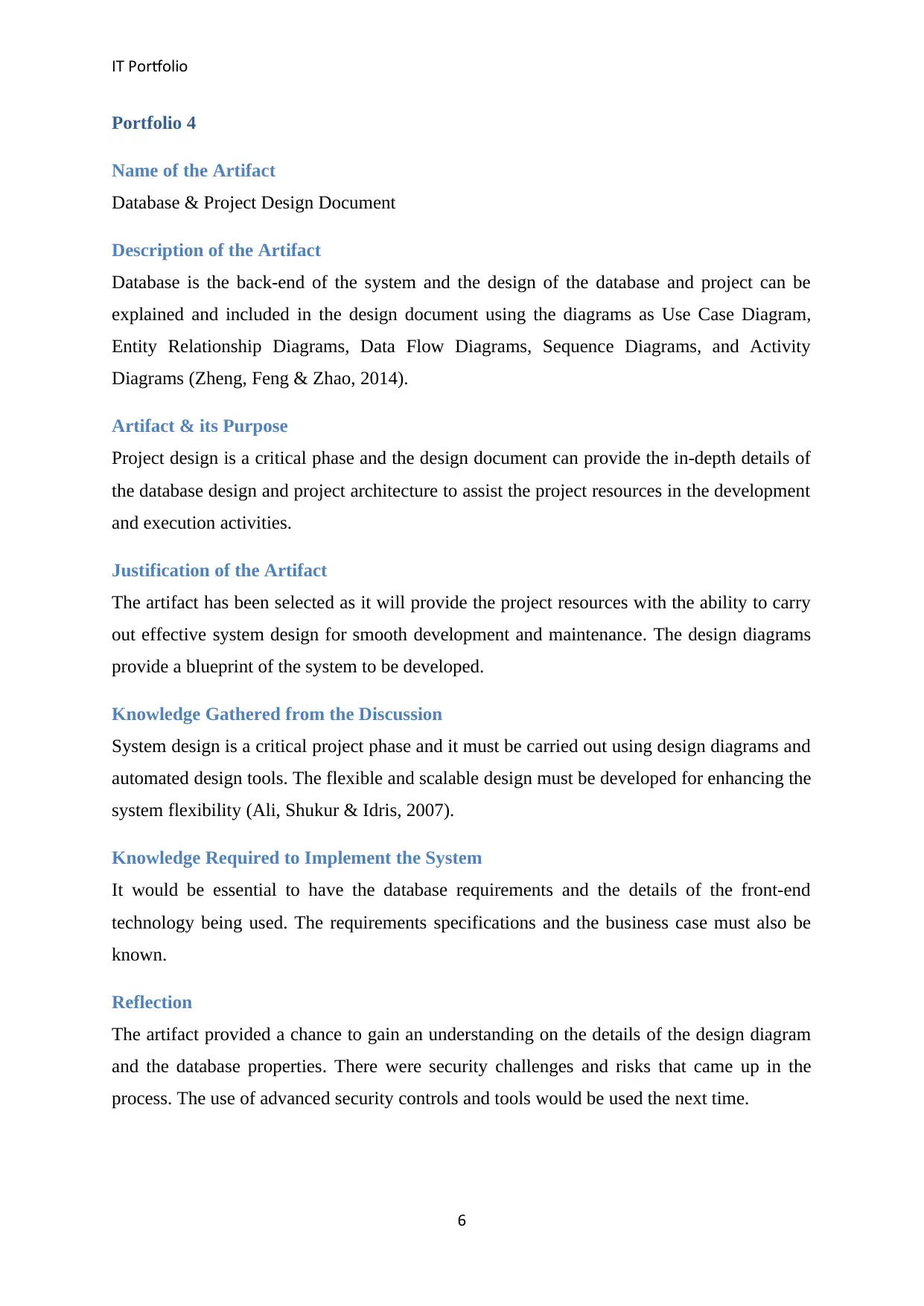
IT Portfolio
Portfolio 4
Name of the Artifact
Database & Project Design Document
Description of the Artifact
Database is the back-end of the system and the design of the database and project can be
explained and included in the design document using the diagrams as Use Case Diagram,
Entity Relationship Diagrams, Data Flow Diagrams, Sequence Diagrams, and Activity
Diagrams (Zheng, Feng & Zhao, 2014).
Artifact & its Purpose
Project design is a critical phase and the design document can provide the in-depth details of
the database design and project architecture to assist the project resources in the development
and execution activities.
Justification of the Artifact
The artifact has been selected as it will provide the project resources with the ability to carry
out effective system design for smooth development and maintenance. The design diagrams
provide a blueprint of the system to be developed.
Knowledge Gathered from the Discussion
System design is a critical project phase and it must be carried out using design diagrams and
automated design tools. The flexible and scalable design must be developed for enhancing the
system flexibility (Ali, Shukur & Idris, 2007).
Knowledge Required to Implement the System
It would be essential to have the database requirements and the details of the front-end
technology being used. The requirements specifications and the business case must also be
known.
Reflection
The artifact provided a chance to gain an understanding on the details of the design diagram
and the database properties. There were security challenges and risks that came up in the
process. The use of advanced security controls and tools would be used the next time.
6
Portfolio 4
Name of the Artifact
Database & Project Design Document
Description of the Artifact
Database is the back-end of the system and the design of the database and project can be
explained and included in the design document using the diagrams as Use Case Diagram,
Entity Relationship Diagrams, Data Flow Diagrams, Sequence Diagrams, and Activity
Diagrams (Zheng, Feng & Zhao, 2014).
Artifact & its Purpose
Project design is a critical phase and the design document can provide the in-depth details of
the database design and project architecture to assist the project resources in the development
and execution activities.
Justification of the Artifact
The artifact has been selected as it will provide the project resources with the ability to carry
out effective system design for smooth development and maintenance. The design diagrams
provide a blueprint of the system to be developed.
Knowledge Gathered from the Discussion
System design is a critical project phase and it must be carried out using design diagrams and
automated design tools. The flexible and scalable design must be developed for enhancing the
system flexibility (Ali, Shukur & Idris, 2007).
Knowledge Required to Implement the System
It would be essential to have the database requirements and the details of the front-end
technology being used. The requirements specifications and the business case must also be
known.
Reflection
The artifact provided a chance to gain an understanding on the details of the design diagram
and the database properties. There were security challenges and risks that came up in the
process. The use of advanced security controls and tools would be used the next time.
6
Paraphrase This Document
Need a fresh take? Get an instant paraphrase of this document with our AI Paraphraser
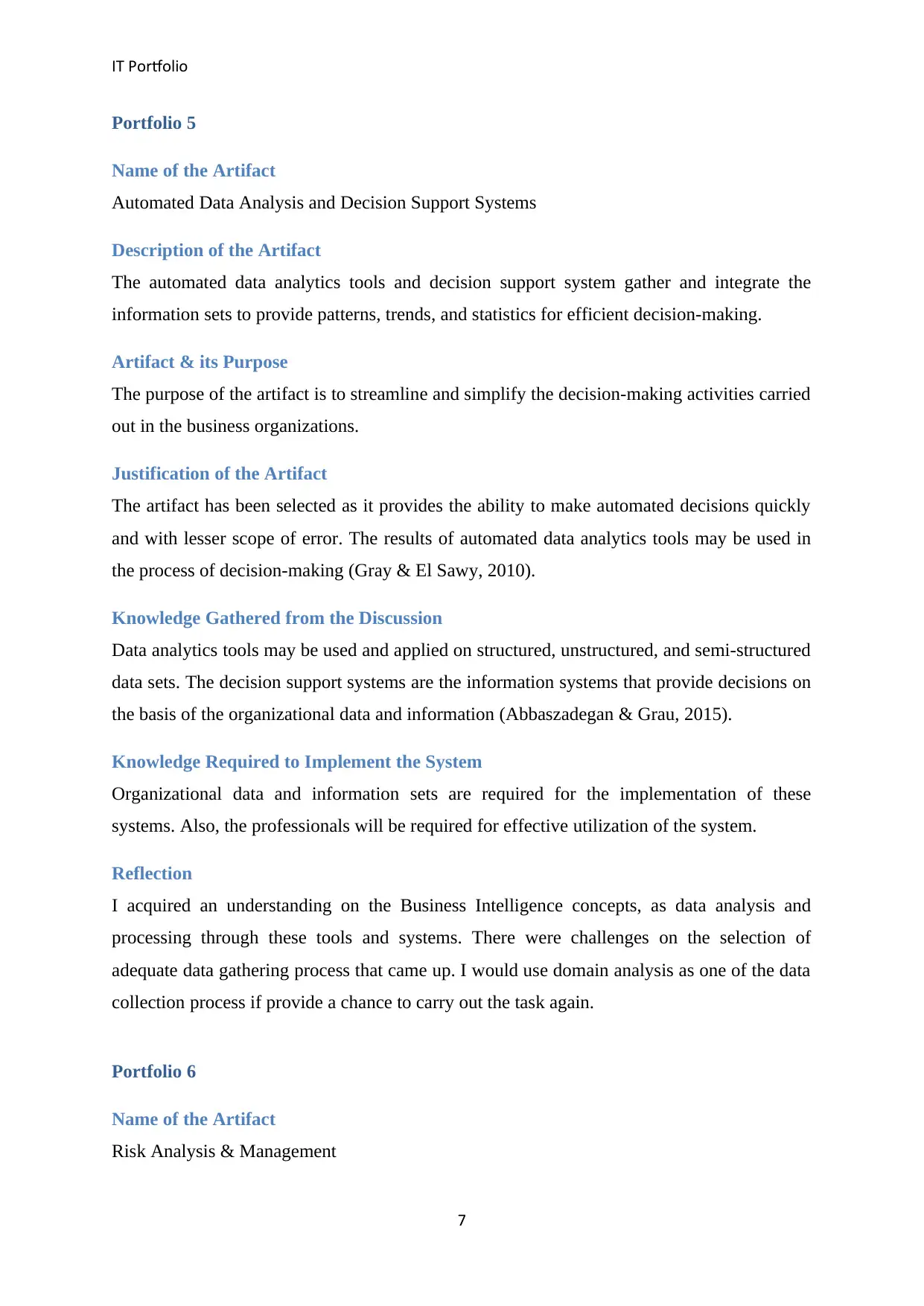
IT Portfolio
Portfolio 5
Name of the Artifact
Automated Data Analysis and Decision Support Systems
Description of the Artifact
The automated data analytics tools and decision support system gather and integrate the
information sets to provide patterns, trends, and statistics for efficient decision-making.
Artifact & its Purpose
The purpose of the artifact is to streamline and simplify the decision-making activities carried
out in the business organizations.
Justification of the Artifact
The artifact has been selected as it provides the ability to make automated decisions quickly
and with lesser scope of error. The results of automated data analytics tools may be used in
the process of decision-making (Gray & El Sawy, 2010).
Knowledge Gathered from the Discussion
Data analytics tools may be used and applied on structured, unstructured, and semi-structured
data sets. The decision support systems are the information systems that provide decisions on
the basis of the organizational data and information (Abbaszadegan & Grau, 2015).
Knowledge Required to Implement the System
Organizational data and information sets are required for the implementation of these
systems. Also, the professionals will be required for effective utilization of the system.
Reflection
I acquired an understanding on the Business Intelligence concepts, as data analysis and
processing through these tools and systems. There were challenges on the selection of
adequate data gathering process that came up. I would use domain analysis as one of the data
collection process if provide a chance to carry out the task again.
Portfolio 6
Name of the Artifact
Risk Analysis & Management
7
Portfolio 5
Name of the Artifact
Automated Data Analysis and Decision Support Systems
Description of the Artifact
The automated data analytics tools and decision support system gather and integrate the
information sets to provide patterns, trends, and statistics for efficient decision-making.
Artifact & its Purpose
The purpose of the artifact is to streamline and simplify the decision-making activities carried
out in the business organizations.
Justification of the Artifact
The artifact has been selected as it provides the ability to make automated decisions quickly
and with lesser scope of error. The results of automated data analytics tools may be used in
the process of decision-making (Gray & El Sawy, 2010).
Knowledge Gathered from the Discussion
Data analytics tools may be used and applied on structured, unstructured, and semi-structured
data sets. The decision support systems are the information systems that provide decisions on
the basis of the organizational data and information (Abbaszadegan & Grau, 2015).
Knowledge Required to Implement the System
Organizational data and information sets are required for the implementation of these
systems. Also, the professionals will be required for effective utilization of the system.
Reflection
I acquired an understanding on the Business Intelligence concepts, as data analysis and
processing through these tools and systems. There were challenges on the selection of
adequate data gathering process that came up. I would use domain analysis as one of the data
collection process if provide a chance to carry out the task again.
Portfolio 6
Name of the Artifact
Risk Analysis & Management
7

IT Portfolio
Description of the Artifact
Risk management is a managerial process and strategy for identification, analysis, mitigation,
and monitoring of the risks in the projects and the business organizations.
Artifact & its Purpose
The purpose of the risk management process is to detect, prevent, and control the risks for
smooth functioning of the organizational operations and activities.
Justification of the Artifact
The artifact has been selected as there may be various risks that may hinder the progress of
the organizational operations. These may include information security risks, project-related
risks, quality risks, ethical risks, and likewise. These need to be prevented and controlled in a
timely manner (Besner & Hobbs, 2012).
Knowledge Gathered from the Discussion
The risk treatment may be done using the strategies as risk avoidance, acceptance, transfer, or
mitigation. There are automated tools that the management may use for risk management.
Knowledge Required to Implement the System
The project details and specifications will be required to implement the risk management
process.
Reflection
I acquired the details on the various risk factors associated with the projects and the strategies
that shall be implemented to reduce the risk probability. There were challenges in the
information collection and gathering processes that came up (Sanchez, Robert, Bourgault &
Pellerin, 2009). I would introduce risk management right from the initiation phase from the
next time onwards.
8
Description of the Artifact
Risk management is a managerial process and strategy for identification, analysis, mitigation,
and monitoring of the risks in the projects and the business organizations.
Artifact & its Purpose
The purpose of the risk management process is to detect, prevent, and control the risks for
smooth functioning of the organizational operations and activities.
Justification of the Artifact
The artifact has been selected as there may be various risks that may hinder the progress of
the organizational operations. These may include information security risks, project-related
risks, quality risks, ethical risks, and likewise. These need to be prevented and controlled in a
timely manner (Besner & Hobbs, 2012).
Knowledge Gathered from the Discussion
The risk treatment may be done using the strategies as risk avoidance, acceptance, transfer, or
mitigation. There are automated tools that the management may use for risk management.
Knowledge Required to Implement the System
The project details and specifications will be required to implement the risk management
process.
Reflection
I acquired the details on the various risk factors associated with the projects and the strategies
that shall be implemented to reduce the risk probability. There were challenges in the
information collection and gathering processes that came up (Sanchez, Robert, Bourgault &
Pellerin, 2009). I would introduce risk management right from the initiation phase from the
next time onwards.
8
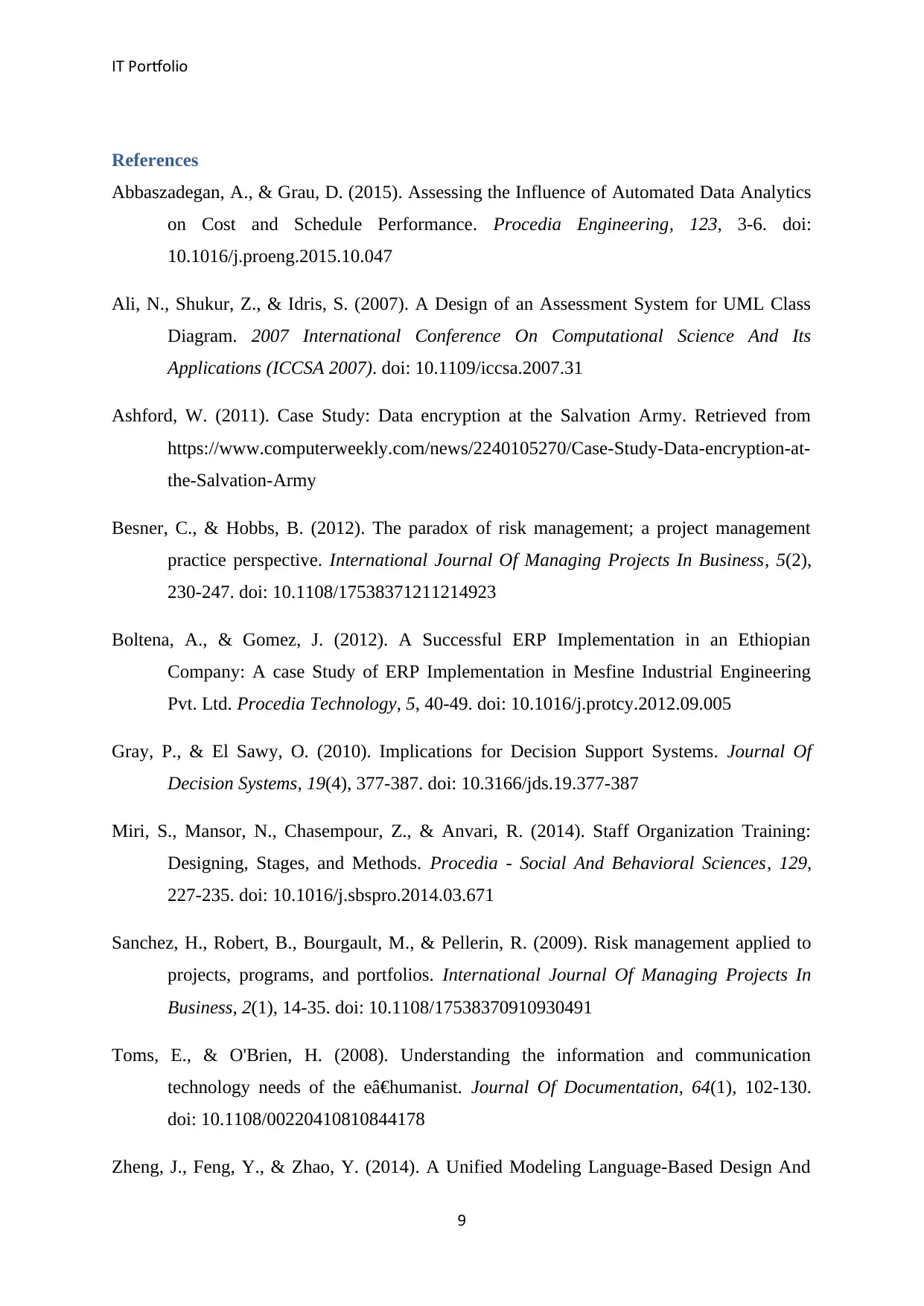
IT Portfolio
References
Abbaszadegan, A., & Grau, D. (2015). Assessing the Influence of Automated Data Analytics
on Cost and Schedule Performance. Procedia Engineering, 123, 3-6. doi:
10.1016/j.proeng.2015.10.047
Ali, N., Shukur, Z., & Idris, S. (2007). A Design of an Assessment System for UML Class
Diagram. 2007 International Conference On Computational Science And Its
Applications (ICCSA 2007). doi: 10.1109/iccsa.2007.31
Ashford, W. (2011). Case Study: Data encryption at the Salvation Army. Retrieved from
https://www.computerweekly.com/news/2240105270/Case-Study-Data-encryption-at-
the-Salvation-Army
Besner, C., & Hobbs, B. (2012). The paradox of risk management; a project management
practice perspective. International Journal Of Managing Projects In Business, 5(2),
230-247. doi: 10.1108/17538371211214923
Boltena, A., & Gomez, J. (2012). A Successful ERP Implementation in an Ethiopian
Company: A case Study of ERP Implementation in Mesfine Industrial Engineering
Pvt. Ltd. Procedia Technology, 5, 40-49. doi: 10.1016/j.protcy.2012.09.005
Gray, P., & El Sawy, O. (2010). Implications for Decision Support Systems. Journal Of
Decision Systems, 19(4), 377-387. doi: 10.3166/jds.19.377-387
Miri, S., Mansor, N., Chasempour, Z., & Anvari, R. (2014). Staff Organization Training:
Designing, Stages, and Methods. Procedia - Social And Behavioral Sciences, 129,
227-235. doi: 10.1016/j.sbspro.2014.03.671
Sanchez, H., Robert, B., Bourgault, M., & Pellerin, R. (2009). Risk management applied to
projects, programs, and portfolios. International Journal Of Managing Projects In
Business, 2(1), 14-35. doi: 10.1108/17538370910930491
Toms, E., & O'Brien, H. (2008). Understanding the information and communication
technology needs of the eâ€humanist. Journal Of Documentation, 64(1), 102-130.
doi: 10.1108/00220410810844178
Zheng, J., Feng, Y., & Zhao, Y. (2014). A Unified Modeling Language-Based Design And
9
References
Abbaszadegan, A., & Grau, D. (2015). Assessing the Influence of Automated Data Analytics
on Cost and Schedule Performance. Procedia Engineering, 123, 3-6. doi:
10.1016/j.proeng.2015.10.047
Ali, N., Shukur, Z., & Idris, S. (2007). A Design of an Assessment System for UML Class
Diagram. 2007 International Conference On Computational Science And Its
Applications (ICCSA 2007). doi: 10.1109/iccsa.2007.31
Ashford, W. (2011). Case Study: Data encryption at the Salvation Army. Retrieved from
https://www.computerweekly.com/news/2240105270/Case-Study-Data-encryption-at-
the-Salvation-Army
Besner, C., & Hobbs, B. (2012). The paradox of risk management; a project management
practice perspective. International Journal Of Managing Projects In Business, 5(2),
230-247. doi: 10.1108/17538371211214923
Boltena, A., & Gomez, J. (2012). A Successful ERP Implementation in an Ethiopian
Company: A case Study of ERP Implementation in Mesfine Industrial Engineering
Pvt. Ltd. Procedia Technology, 5, 40-49. doi: 10.1016/j.protcy.2012.09.005
Gray, P., & El Sawy, O. (2010). Implications for Decision Support Systems. Journal Of
Decision Systems, 19(4), 377-387. doi: 10.3166/jds.19.377-387
Miri, S., Mansor, N., Chasempour, Z., & Anvari, R. (2014). Staff Organization Training:
Designing, Stages, and Methods. Procedia - Social And Behavioral Sciences, 129,
227-235. doi: 10.1016/j.sbspro.2014.03.671
Sanchez, H., Robert, B., Bourgault, M., & Pellerin, R. (2009). Risk management applied to
projects, programs, and portfolios. International Journal Of Managing Projects In
Business, 2(1), 14-35. doi: 10.1108/17538370910930491
Toms, E., & O'Brien, H. (2008). Understanding the information and communication
technology needs of the eâ€humanist. Journal Of Documentation, 64(1), 102-130.
doi: 10.1108/00220410810844178
Zheng, J., Feng, Y., & Zhao, Y. (2014). A Unified Modeling Language-Based Design And
9
Secure Best Marks with AI Grader
Need help grading? Try our AI Grader for instant feedback on your assignments.
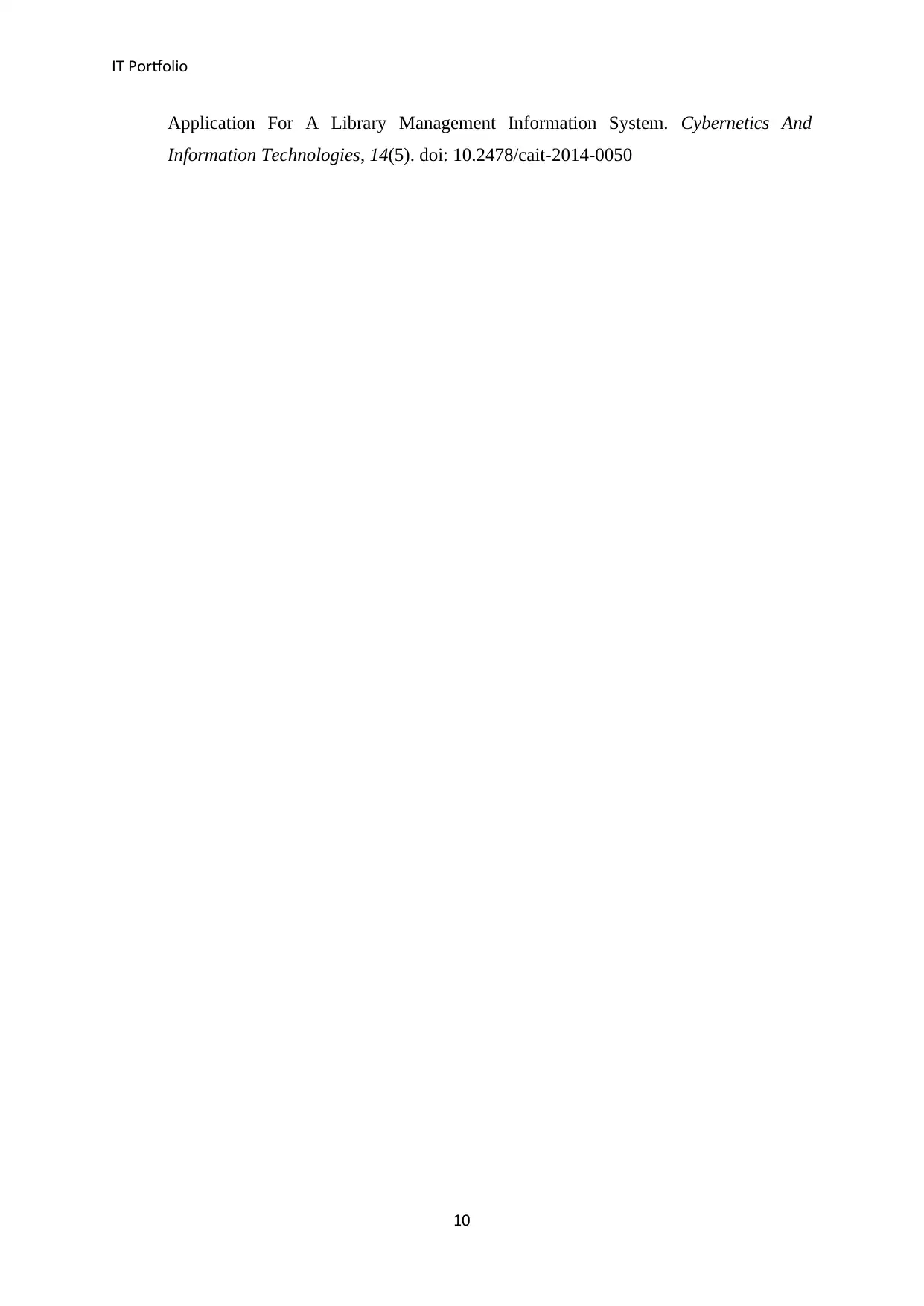
IT Portfolio
Application For A Library Management Information System. Cybernetics And
Information Technologies, 14(5). doi: 10.2478/cait-2014-0050
10
Application For A Library Management Information System. Cybernetics And
Information Technologies, 14(5). doi: 10.2478/cait-2014-0050
10
1 out of 11
Related Documents
Your All-in-One AI-Powered Toolkit for Academic Success.
+13062052269
info@desklib.com
Available 24*7 on WhatsApp / Email
![[object Object]](/_next/static/media/star-bottom.7253800d.svg)
Unlock your academic potential
© 2024 | Zucol Services PVT LTD | All rights reserved.




